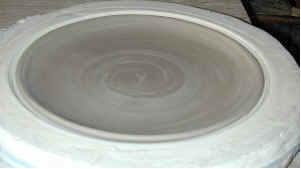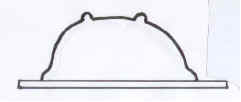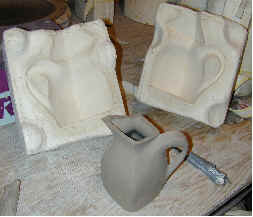|
Eleanora Eden
back to home page |
Plaster Casting Explanation - page 2 | |
 Figure 5 shows the finished plate casting still wet in its 1-piece mold. When it dries in a day or two the plate will be carefully turned out. Such a plate as this might well have a foot already as part of the casting. |
|
|
|
Molds can be made from any kind of object. And there are different kinds of molds. Also note that casting can be formulated for any temperature range, same as a throwing clay. Commercial slips are commonly available in both red and white clays for low, mid-range, and high temperature firings. The mold-making I do is from damp, usually solid, clay models. This is cause it is easiest. The models can be made well in advance but just don't let them dry out. The molds I make are specifically designed for use with casting slip. This differs greatly from press-molding, where you have both the outside and the inside of the piece and the clay is squished between them in a press. With slip-molding it is the outside of the form that is being molded. Visualizing how to jump from the bowl or plate you want to the solid clay model you need requires some practice. Draw the silhouette (the cross-section) of the piece you want, focusing on the exact shape desired for the outside of the pot. Turn this drawing upside down. (This is how the solid clay model will look on its bat, ready to pour the plaster over it.) Throw or sculpt this shape on a flat, smooth bat or board that measures at least 2" bigger than the model all around. Here are cross-section examples of 1-piece castings, a bowl and a footed bowl: |
||

|

|
|
| Here is each of these examples turned upside down on a bat, ready to make a mold. These models are SOLID CLAY, thrown as a shaped lump on the bat. | ||

|

|
|
| back to page 1 on to page 3 | back to home page | |
